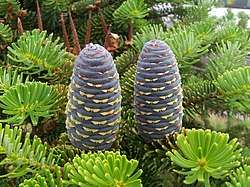Fir
Firs (Abies) are about 45-55 species of evergreen trees in the family Pinaceae. Fir trees can reach heights of 10–80 m tall and trunk diameters of 0.5–4 m when mature. The difference between firs and other members of the pine family is that their needle-like leaves are attached to the twig by a base that resembles a small suction cup, and by erect, cylindrical female cones 5–25 cm long that release the winged seeds. The male cones are normally much smaller and spread through the tree so that the wind can help pollinate the female cones.[1]
| Abies - firs | |
|---|---|

| |
| Korean Fir (Abies koreana) cone and foliage | |
| Scientific classification | |
| Kingdom: | |
| Division: | |
| Class: | |
| Order: | |
| Family: | |
| Genus: | Abies |
| Species | |
|
See text | |
Like all members of the pine family, these trees have a sticky sap called resin.
Fir wood is not good to use in buildings because it is not very resistant to insects and decay. It is usually cut or squeezed into thin sheets or pieces and made into plywood or chipboard for indoor or temporary outdoor use.[2] However, fir trees are used widely in gardening. They can be used as shelter trees to protect other plants from wind or grown alone as decorative trees.[1]
| Wikispecies has information on: Abies. |
Fir Media
A. fabri, Sichuan, China
A. magnifica, California, USA
Green fir twig pictured on top of heart in the coat of arms of Laukaa
Most firs are inbetween the two extremes of flat and radial, with an intermediate arrangement, often with longer leaves at the sides, and shorter leaves above the shoot; here, A. mariesii in Japan
References
- ↑ 1.0 1.1 The RHS Encyclopedia of Garden Plants, edited by Christopher Brickell, Dorling Kindersley, London, 1996, ISBN 0751304360. p56
- ↑ :en:Fir#Uses_and_ecology













